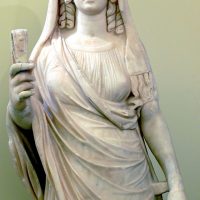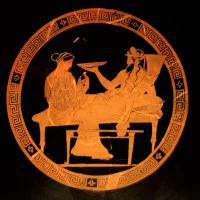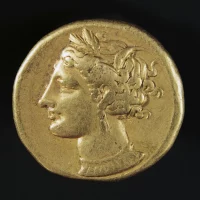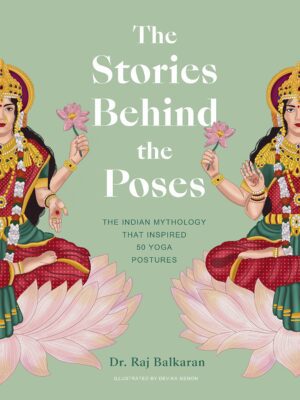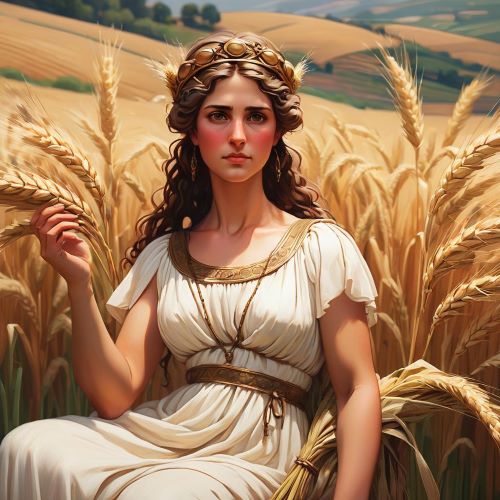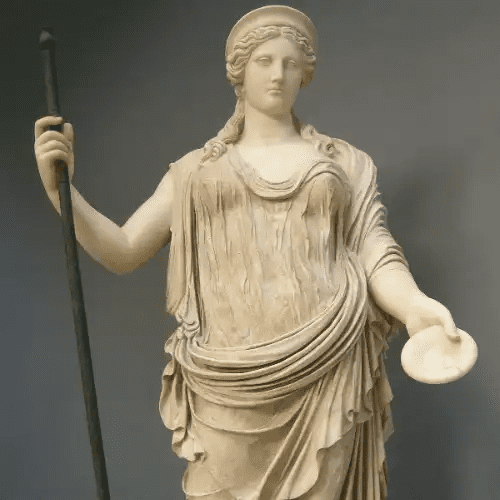Persephone : Queen of the Underworld
Listen
At a glance
| Description | |
|---|---|
| Origin | Greek Mythology |
| Classification | Gods |
| Family Members | Zeus (Father), Demeter (Mother), Hades (Husband) |
| Region | Greece |
| Associated With | Underworld, Spring, Seasons |
Persephone
Introduction
Persephone, also referred to as Kore, is a central figure in Greek mythology, embodying the intricate balance between life and death. As the Goddess of Spring and the Queen of the Underworld, she symbolizes the cyclical nature of existence and the ever-changing seasons. Born to Demeter, the goddess of agriculture, and Zeus, the king of gods, Persephone’s narrative is one of abduction, resilience, and the perpetual cycle of life and death. Her story intertwines themes of transformation and familial bonds, captivating audiences across generations. Persephone’s name evokes the essence of springtime, representing both the vibrancy of life and the quietude of the underworld’s realm.
Physical Traits
In ancient portrayals, Persephone is depicted as a stunning young woman, often holding sheaves of grain to symbolize the harvest. Occasionally, she is seen with a scepter or a cornucopia, emblematic of her authority and the earth’s abundance. Her beauty is described as unparalleled, with cascading ebony hair crowned by a wreath of flowers representing spring’s bloom. Her eyes, profound as the underworld’s abyss, harbor a wisdom surpassing her tender age.
Artists across eras have strived to capture her ethereal charm, portraying her as a fusion of innocence and authority. Known alternately as Kore, denoting her maiden status, she was celebrated for her captivating allure. Ancient poets lauded her rosy cheeks, golden locks, and eyes that shimmered with youthful innocence. Adorned with flowers symbolizing her association with spring, her depictions sometimes hint at a melancholic depth, imbuing her with a subdued wisdom amidst her youthful radiance.
Family
Persephone’s family lineage is as intricate as the myths that envelop her. Born to Zeus, the omnipotent king of the gods, and Demeter, the nurturing goddess of agriculture, her abduction by Hades, the ruler of the underworld, is said to have catalyzed the genesis of the seasons in Greek lore. Raised amidst the bounties of nature, Persephone shared a profound connection with her mother, whose anguish over her daughter’s abduction is believed to have instigated the seasonal changes. Persephone’s union with Hades further complicates her familial ties, casting her simultaneously as a queen and a daughter of two disparate realms.
Her family dynamic is complex, with Zeus’s reputation for infidelity contrasting sharply with Demeter’s unwavering love for her daughter. Demeter’s sorrow over Persephone’s fate plunged the world into winter, showcasing the depth of their bond. The specifics of Persephone’s sibling relationships vary across retellings, with some versions mentioning a half-brother, Plutus, the god of wealth, born from Zeus and Demeter’s union. Persephone’s forced marriage to Hades reshaped her family dynamics once more. While Hades is often depicted as a somber deity of the underworld, differing interpretations suggest a more nuanced relationship with Persephone. Despite her initial reluctance, Persephone eventually finds solace in her role as queen of the underworld, forging a unique bond with Hades amidst the shadowy depths of their domain.
Other names
Persephone’s identity is as multifaceted as the realms she governs. In her youthful guise, she is often referred to as Kore, symbolizing her innocence and connection to spring. Other epithets, such as Despoina (“mistress”), Phaethousa (“the shining one”), and Thesmophoros (“lawgiver”), highlight the diverse facets of her persona. These titles encapsulate not only the beauty of spring but also the authority and wisdom she wields as queen of the underworld. Beyond Kore, Persephone is known by various names that underscore different aspects of her character. In Roman mythology, she is recognized as Proserpina, further expanding the depth of her mythological significance. Each epithet offers a unique perspective on Persephone’s identity, enriching her portrayal with layers of symbolism and meaning.
Powers and Abilities
Persephone’s dual role as the Goddess of Spring and Queen of the Underworld grants her a unique and complex set of abilities, bridging the realms of life and death. In her guise as the bringer of spring, she orchestrates the renewal of life, coaxing forth the blossoms and verdure that herald the arrival of warmer days. Conversely, as the sovereign of the underworld, she commands the spirits of the deceased with an authority tempered by compassion. Her ability to traverse between these realms underscores her role as a mediator between the living and the departed, embodying the cyclical essence of existence and the interconnectedness of all things.
Persephone’s powers are multifaceted, reflecting her diverse roles in both the mortal and immortal realms. As the Goddess of Spring, she holds sway over the fecundity of the earth, nurturing growth and renewal. Conversely, as the Queen of the Underworld, she governs over the souls of the departed, guiding them with wisdom and compassion. Additionally, Persephone’s association with the Eleusinian Mysteries further underscores her significance in matters of life and death, offering initiates a glimpse into the mysteries of the afterlife.
Central to Persephone’s myth is her abduction by Hades, an event that catalyzed the creation of the seasons according to Greek lore. While sanctioned by Zeus, her father, the abduction was met with vehement opposition from Demeter, her mother, whose grief plunged the world into an unyielding winter. The subsequent compromise, brokered by Zeus, saw Persephone splitting her time between the underworld and the mortal realm, thus establishing the cycle of seasons that endures to this day.
While the core narrative of Persephone’s abduction remains consistent across various retellings, nuances in the story offer alternative perspectives on her relationship with Hades and the circumstances of her descent. Some versions suggest Persephone’s consumption of pomegranate seeds in the underworld bound her to its confines, while others hint at a more nuanced connection between her and Hades, casting their relationship in a softer light. Regardless of interpretation, Persephone’s myth endures as a timeless allegory for the cyclical nature of life and the interconnectedness of all things.
Modern Day Influence
Persephone’s enduring relevance in modern culture is undeniable, as her tale of rebirth and personal evolution continues to captivate audiences across various artistic mediums. From literature to visual arts, Persephone’s myth has been reimagined in countless forms, including ballets, operas, and novels. The archetype of Persephone serves as the foundation for the popular “Persephone” trope in literature, where characters journey to the underworld and emerge transformed, often imbued with newfound wisdom or strength.
In contemporary retellings, Persephone’s story serves as a poignant allegory for resilience, identity, and the inevitability of change. Through her trials and triumphs, she emerges as a heroine navigating the complexities of her divine lineage. This narrative resonates with modern audiences, offering reflections on empowerment and the resilience required to overcome trauma.
The duality inherent in Persephone’s role as both queen of the underworld and goddess of spring sparks contemplation on themes of balance, life, and death. Her story prompts exploration into the cyclical nature of existence and the interplay between light and darkness. These themes find expression in various artistic mediums, from literature to visual arts.
In literature, Persephone’s influence is evident in both classic and contemporary works, where her character symbolizes themes of female identity, strength, and resilience. Artists continue to be inspired by Persephone’s multifaceted persona, capturing her beauty, sorrow, and inner strength in paintings, sculptures, and photography. Through their creations, Persephone’s timeless allure and significance endure, enriching modern culture with her enduring presence.
Related Images
Newest addition
Frequently Asked Questions
What is lorem Ipsum?
I am text block. Click edit button to change this text. Lorem ipsum dolor sit amet, consectetur adipiscing elit. Ut elit tellus, luctus nec ullamcorper mattis, pulvinar dapibus leo.
What is lorem Ipsum?
I am text block. Click edit button to change this text. Lorem ipsum dolor sit amet, consectetur adipiscing elit. Ut elit tellus, luctus nec ullamcorper mattis, pulvinar dapibus leo.
What is lorem Ipsum?
I am text block. Click edit button to change this text. Lorem ipsum dolor sit amet, consectetur adipiscing elit. Ut elit tellus, luctus nec ullamcorper mattis, pulvinar dapibus leo.
What is lorem Ipsum?
I am text block. Click edit button to change this text. Lorem ipsum dolor sit amet, consectetur adipiscing elit. Ut elit tellus, luctus nec ullamcorper mattis, pulvinar dapibus leo.
What is lorem Ipsum?
I am text block. Click edit button to change this text. Lorem ipsum dolor sit amet, consectetur adipiscing elit. Ut elit tellus, luctus nec ullamcorper mattis, pulvinar dapibus leo.


